Paarl
Paarl (/ˈpɑːrl/; Afrikaans: [ˈpɑːrl̩]; derived from Parel, meaning "pearl" in Dutch[2]) is a city with 112,045 inhabitants in the Western Cape province of South Africa. It is the third-oldest city and European settlement in the Republic of South Africa (after Cape Town and Stellenbosch) and the largest town in the Cape Winelands. Due to the growth of the Mbekweni township, it is now a de facto urban unit with Wellington. It is situated about 60 kilometres (37 mi) northeast of Cape Town in the Western Cape Province and is renowned for its haunting scenic beauty pand deep viticulture and fruit-growing heritage.
Paarl | |
|---|---|
 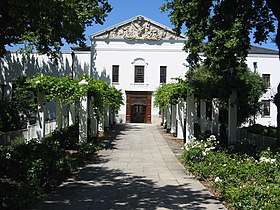  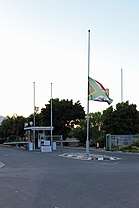 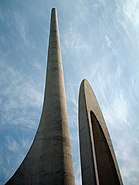 From top, left to right: Paarl from the summit of Paarl Mountain, looking across to the Klein-Drakenstein and Du Toitskloof Mountains, KWV, Drakenstein Correctional Centre, Tower Church, Afrikaanse Taalmonument, Strooidak Church. | |
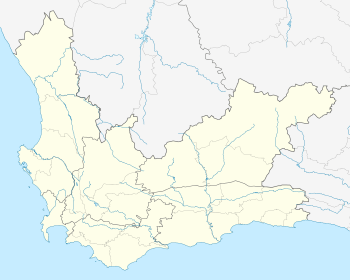 Paarl  Paarl  Paarl | |
| Coordinates: 33°43′27″S 18°57′21″E | |
| Country | |
| Province | Western Cape |
| District | Cape Winelands |
| Municipality | Drakenstein |
| Established | 1687 |
| Area | |
| • Total | 64.61 km2 (24.95 sq mi) |
| Elevation | 120 m (390 ft) |
| Population (2011)[1] | |
| • Total | 112,045 |
| • Density | 1,700/km2 (4,500/sq mi) |
| Racial makeup (2011) | |
| • Black African | 10.4% |
| • Coloured | 69.9% |
| • Indian/Asian | 0.6% |
| • White | 17.9% |
| • Other | 1.3% |
| First languages (2011) | |
| • Afrikaans | 86.8% |
| • English | 6.2% |
| • Xhosa | 4.6% |
| • Other | 2.4% |
| Time zone | UTC+2 (SAST) |
| Postal code (street) | 7646 |
| PO box | 7620 |
| Area code | 021 |
Paarl is the seat of the Drakenstein Local Municipality; although not part of the Cape Town metropolitan area, it falls within its economic catchment. Paarl is unusual among South African place-names, in being pronounced differently in English than in Afrikaans; likewise unusual about the town's name is Afrikaners customary attachment to it, saying not in Paarl, but rather in die Paarl, or in die Pêrel (literally, "in the Paarl").
Paarl gained international attention when, on 11 February 1990, Nelson Mandela walked, with live international Television coverage, out of Victor Verster Correctional Centre (now known as Drakenstein Correctional Centre) in Paarl ending his 27 years of imprisonment, and beginning a course to South Africa's post-apartheid era and, notably, to multi-racial elections.[3] Mandela spent three years in prison here living in a private house within the walls. Today, a bronze statue of Mandela stands outside the prison.
Paarl hosted a match from the ICC Cricket World Cup 2003. The headquarters of Ceres Fruit Juices is located in the city, although its namesake and source of much of the fruit, Ceres Valley, lies around one hour's drive to the northeast.
The district is particularly well known for its Pearl Mountain or "Paarl Rock". This huge granite rock is formed by three rounded outcrops and has been compared in majesty to Uluru (formerly known as Ayers Rock) in Australia. (However, they are not geologically similar. Paarl Rock consists of intrusive igneous rock, while Uluru is a sedimentary remnant)
History
The area that is now known as Paarl was first and is still inhabited by the Khoekhoe. The Peninsular Khoikhoi people and the Cochoqua people live in this area divided by the Berg River Valley. The Cochaqua were cattle-herding people and among the richest of the Khoi tribes. They had between 16,000-18,000 members and originally called Paarl Mountain, Tortoise Mountain.[4]
The Dutch East India Company, under the leadership of Jan van Riebeeck, established meat-trading relationships with the Khoikhoi people on the Table Bay coastline. In 1657, in search of new trading relationships inland, Abraham Gabemma saw a giant granite rock glistening in the sun after a rainstorm and named it "de Diamondt en de Peerlberg" (Diamond and Pearl Mountain), from which Paarl is derived.[2][5] Gabemma (often also spelt Gabbema) was the Fiscal (public treasurer) for the settlement on the shores of Table Bay. The "diamonds" disappeared from the name, and it became known simply as Pearl Rock or Pearl Mountain.
In 1687, Governor Simon van der Stel gave the title to the first colonial farms in the area to "free burghers". The following year, the French Huguenots arrived in the Western Cape and began to settle on farms in the area.[4] The fertile soil and the Mediterranean-like climate of this region provided perfect conditions for farming. The settlers planted orchards, vegetable gardens and, above all, vineyards.[6] Thus began Paarl's long and continuing history as a major wine- and fruit-producing area of South Africa.
In 1875 a congregation was formed out of a desire to be educated in their mother tongue. This was the result of a Reverend GWA van der Lingen idea who tried to motivate and convince people of his principles. The congregation would raise funds and begin construction of a church that would later be known as the "Toring Kerk" (Tower Church). Construction finished in 1905. The church contains materials imported from London and Egypt.[7]
The arrival of the European settlers brought on a conflict with the Khoikhoi people, as land and water resources began to be contested and the Khoi traditions of communal land use came in conflict with the settler's concept of private property. The Khoi peoples were defeated in local war and were further decimated by European diseases. The population scattered inland toward the Orange River or became labourers on settler farms.[4]
Demographics
In the 2001 census Paarl's population was recorded as being 82,713 people in 20,138 households, in a land area of 32.2 square kilometres (12.4 sq mi). 67.8% of the inhabitants described themselves as "Coloured", 21.2% as "White", 10.5% as "Black African", and 0.5% as "Indian or Asian". 85.5% spoke Afrikaans as their first language, 8.5% spoke Xhosa, and 5.2% spoke English.[8]
Tourist attractions
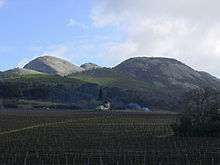
Like many towns in the Cape Winelands, Paarl is home to a prosperous community, with many well maintained and attractive Cape Dutch houses, beautiful gardens and streets lined with old oak trees.
Paarl boasts a unique cultural attraction: it was here that the foundations of the Afrikaans language were laid by the Genootskap van Regte Afrikaners. The "Afrikaanse Taalmonument" (monument to the Afrikaans language) on the slopes of Paarl Mountain, the Language Museum (Taalmuseum) and the Afrikaans Language Route through Dal Josaphat are memorials to this achievement.
The former headquarters of the wine industry in South Africa is also situated here. This was the famous "Co-operative Wine Growers' Association" (better known by its Afrikaans initials KWV). KWV became a South African institution that has acquired an international reputation based on its unique achievements and its imprint of quality on the local wine industry. Over the past decade, however, KWV has been privatized and no longer has an administrative role in the South African wine industry. (KWV's main wine production and maturation facilities are on its Paarl premises, while its brandy production takes place in Worcester and grape juice concentrate production in Upington in the Northern Cape.)
The town and its surroundings attract many visitors with an array of activities and interests. There are magnificent Cape Dutch buildings (17-19th Century), scenic drives, hiking trails, excellent restaurants and the Paarl wine route, with its many wine tasting opportunities.[9]
The old Spice Route Paarl, which was initiated in 1997 by Charles Back, the owner of this estate as well as of Fairview, provides an opportunity for visitors to appreciate and taste local delicacies from the Western Cape, like biltong, draft beer or red and white wines from the surrounding wine yards in Malmesbury and Darling. Back's vision was "to offer local and international tourists a selection of hand-picked artisanal producers who put as much thought, skill and passion into their products as Spice Route winemaker, Charl du Plessis, puts into his wines".[10] Besides that a range of art galleries and the traditional way of organic dark chocolate production can be explored. The heritage of the Spice Route farm goes back to the historical mariners who used to trade Eastern spices to Europe along the "Spice Route" for spice trade in the 15th century.[11]
The Paarl Rock itself is these days a popular Mecca for rock climbers. However, in the pioneering period of rock climbing in South Africa, the mountain was ignored or shunned because its steep faces were so smooth and unfissured that climbers could find no place to attach "runners" or anchor points for belays. The first climbing routes up the rock were pioneered in 1969 by J. W. Marchant and G. Athiros, the former from the University of Cape Town Mountain and Ski Club. Soon afterwards Marchant and John Knight established a few routes on which the rope was run out for 100 m (330 ft) or more with no protection whatsoever.[12] This was in the days before bolting was possible, and these achievements are still held in high regard today. Nowadays protection is afforded by bolts in the granite, and there are on Paarl Rock a few dozen spectacular, beautiful and very hard routes that attract the best climbers of the current generation. (All of these climbs remain dangerous for the inexperienced.) A guidebook for these routes was written in 2006 by Stewart & Scott Noy, who lived at the foot of the mountain and were developing many of the new routes at the time.
Districts
Amongst the neighbourhoods include De Zoete Inval (a middle-class suburb in the south); Courtrai (a wealthy suburb in the southern part of town); Central Paarl (generally known as Upper-Paarl and also containing a lot of wealthy suburbs, popular area for local Jews); Lemoenkloof (a wealthy suburb between the central and northern parts of town); Northern Paarl (middle-class suburb, including the area of Groenvlei); Denneburg (in the south-east of the town); Vrykyk (in the south) and areas in the eastern part of the town such as New Orleans, New York, Amstelhof, Lantana and Klein Nederburg.
There are also large gated communities developed towards the South of the town on the way to Franschhoek, such as Boschenmeer (golf estate), Val de Vie Estate (polo estate) and Pearl Valley (golf estate).
Education
The town boasts some of the best governmental academic high schools in the country including Paarl Gimnasium High School, La Rochelle Girls' High School, Paarl Boys' High School, Paulus Joubert High, New Orleans Secondary, Klein Nederburg Secondary and Paarl Girls' High. Paarl Girls' High was placed 17th in the National Senior Certificate's "Excellence in academic performance" awards in 2012. New Orleans Secondary is the school where the completed her secondary education. Independent schools such as Simond Private School (est. 1852) and Bridge House also feature in this region. Bridge House, listed as one of the most expensive independent schools in South Africa, offers boarding facilities. These schools offer the IEB examinations as distinct from the National Senior Certificate offered by government schools.[13]
Climate
| Climate data for Paarl | |||||||||||||
|---|---|---|---|---|---|---|---|---|---|---|---|---|---|
| Month | Jan | Feb | Mar | Apr | May | Jun | Jul | Aug | Sep | Oct | Nov | Dec | Year |
| Average high °C (°F) | 29.7 (85.5) |
30.0 (86.0) |
28.6 (83.5) |
24.8 (76.6) |
20.7 (69.3) |
18.6 (65.5) |
17.7 (63.9) |
18.4 (65.1) |
20.5 (68.9) |
23.6 (74.5) |
26.7 (80.1) |
28.4 (83.1) |
24.0 (75.2) |
| Daily mean °C (°F) | 22.7 (72.9) |
23.0 (73.4) |
21.6 (70.9) |
18.3 (64.9) |
14.9 (58.8) |
12.8 (55.0) |
12.0 (53.6) |
12.7 (54.9) |
14.5 (58.1) |
17.2 (63.0) |
19.9 (67.8) |
21.5 (70.7) |
17.6 (63.7) |
| Average low °C (°F) | 15.8 (60.4) |
16.1 (61.0) |
14.6 (58.3) |
11.8 (53.2) |
9.1 (48.4) |
7.0 (44.6) |
6.3 (43.3) |
7.0 (44.6) |
8.6 (47.5) |
10.9 (51.6) |
13.2 (55.8) |
14.7 (58.5) |
11.3 (52.3) |
| Average precipitation mm (inches) | 16 (0.6) |
21 (0.8) |
26 (1.0) |
73 (2.9) |
117 (4.6) |
132 (5.2) |
116 (4.6) |
109 (4.3) |
61 (2.4) |
49 (1.9) |
29 (1.1) |
21 (0.8) |
770 (30.2) |
| Source: Climate-Data.org [14] | |||||||||||||
Notable residents
- Kathleen Aerts - Belgian singer
- Lynne Brown - former Premier of the Western Cape
- Archie Crail - writer
- Willem de Waal - rugby union player
- Jean de Villiers - rugby union player
- Peter de Villiers - former coach of the South Africa national rugby union team (Springboks)
- Deetlefs du Toit – former South African politician
- Stephanus Jacobus du Toit - Taalstryder (language warrior)
- Jacob Daniël du Toit (Totius) - (Born Paarl 1877) poet and Taalstryder
- David James - actor
- Wilmot James - former Member of Parliament
- Elsa Joubert - author
- Marius Charl Joubert - rugby union player
- Wayne Julies - rugby union player
- Margaret Lawder - botanist
- Nelson Mandela - released from Victor Vester Prison in Paarl on 11 February 1990
- Eugène Marais - author and poet
- Deon Meyer - thriller novelist
- Ryk Neethling - swimmer and Olympian
- Justin Lee Ontong - cricketer Cape Cobras
- Wendy Philander - Member of the Western Cape Provincial Parliament[15]
- Conrad Poole – mayor of the Drakenstein
- Karel Schoeman - author
- Gurthro Steenkamp - rugby union player
- Louis Theodor Weichardt - founder and leader of the Greyshirts
- Chester Mornay Williams - rugby union player
Coats of arms
Municipality (1) — On 18 July 1905, the municipal council accepted a coat of arms presented by Adriaan Moorrees.[16] It was the arms of Hendrik van Reede van Drakenstein : a silver shield charged with two dancetty black bars and crowned with a golden coronet. The supporters were two golden gryphons. The motto was Pour le salut du peuple ("For the wellbeing of the people"). Sometimes, the arms were depicted as silver dancetty bars on a blue shield.

Municipality (2) — The arms were re-designed in 1950 by Colin Graham Botha, and granted by the College of Arms on 22 January 1951. They were published in the Cape Province's Official Gazette in 1955, re-granted by the provincial administrator in 1967, and certified by the Bureau of Heraldry in 1969.[17]
In the new version, each of the dancetty bars on the shield displayed two pearls; the supporters were red with blue wings dotted with golden fleurs de lis; and the crest was a red demi-gryphon with blue wings holding a bunch of grapes.
Divisional Council — The divisional council was the local authority which administered the rural areas outside the town. It registered a coat of arms at the Bureau of Heraldry on 20 October 1978. Once again, the Van Reede shield formed the basis of the design. Down the middle of the shield was a red pale displaying a bunch of grapes between two pearls. The crest was a fleur de lis. The motto was Animus et fata ("Courage and fortune").[17]
Mbekweni — The local authority for the Black township of Mbekweni registered arms at the Bureau on 5 May 1989. The shield is divided per chevron into red and green, with a golden chevron rompu across the centre and a silver cross pommy below it. Above the arms was a green mural crown decorated with a band of red edged in gold. The motto was uXolo neMpulelelo.[17]
See also
References
- "Main Place Paarl". Census 2011.
- Raper, P. E. Paarl. Dictionary of Southern African Place Names. Retrieved 28 October 2013.
- BBC on this Day 11 Feb 1990: Freedom of Nelson Mandela
- "Archived copy". Archived from the original on 12 June 2011. Retrieved 26 March 2011.CS1 maint: archived copy as title (link)
- The concise illustrated South African Encyclopaedia. P. Schirmer, 1980. Central News Agency, Johannesburg. First edition, about 211pp
- A General Collection of the Best and Most Interesting Voyages and Travels in All Parts of the World, Vol XVI. John Pinkerton, 1814. London: Longman, Hurst, Rees, and Orme.
- NG Toringkerk pamphlet handed out by the church itself
- "Main Place 'Paarl'". Census 2001. Retrieved 2 April 2011.
- "Things to do in Paarl | Paarl Directory". www.paarldirectory.co.za. Retrieved 29 February 2016.
- "Spice Route Destination | Paarl, South Africa". www.spiceroute.co.za. Retrieved 18 August 2015.
- "The Swartland Revolution | Spice Route Winery". www.spiceroutewines.co.za. Archived from the original on 21 September 2015. Retrieved 18 August 2015.
- Annual Bulletin. University of Cape Town Mountain and Ski Club (UCTMSC), 1970.
- "Archived copy" (PDF). Archived from the original (PDF) on 12 June 2013. Retrieved 13 June 2013.CS1 maint: archived copy as title (link)
- "Climate: Paarl". Retrieved 14 April 2018.
- Bearing Drakenstein flag in the provincial legislature
- Western Cape Archives : Paarl Municipal Minutes (18 July 1905).
- National Archives of South Africa : Data of the Bureau of Heraldry
.svg.png)